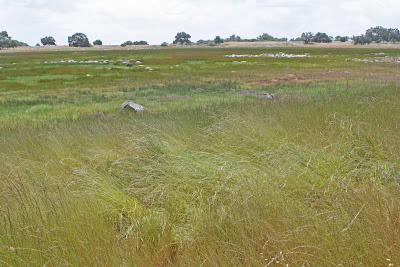A cool and breezy day today, perfect for trekking out to the Plateau. I had read last week in Theodore Payne's weekly wildflower report that the Hoover's Downingias were in full bloom at the main vernal pool. So of course, we had to drop everything and go (and by 'we' I'm speaking collectively for both Gil & myself, even though I'm sure he would have rather been at home with the pooch watching the History Channel or Military Channel). That's how absolutely fab and important these little gems are to the raison d'etre of any mildly obsessive-compulsive wildflower watcher. The Downingias, needless to say, did not disappoint.
5/22/10 Hoover's Downingia (Downingia bella), Main vernal pool.
And as the masses of grasses begin their slouching towards senescence, I must admit that there's beauty in old, as there's beauty in gold.
The Downingias were definitely the icing, but these wildflowers were certainly the cake. Here's the rundown on some of the other stuff blooming along the Vernal Pool Trail:
Wild Hyacinth (
Dichelostemma capitatum ssp. capitatum)
Long-Beaked Filaree (
Erodium botrys)
Western Buttercup (
Ranunculus occidentalis)
Splendid Mariposa Lily (
Calochortus splendens)
California Poppy (
Eschscholzia californica)
Checkerbloom (
Sidalcea malviflora ssp. sparsiflora)
Hooked Popcorn Flower (at main vernal pool) (
Plagiobothrys undulatus)
Wine Cup Clarkia (
Clarkia purpurea ssp. quadrivulnera)
Thread-leaved Brodiaea (
Brodiaea filifolia)
Clover Fern (at main vernal pool) (
Marsilea vestita)
Brass Buttons* (at main vernal pool) (
Cotula coronopifolia)
Wild Morning Glory (
Calystegia macrostegia)
Slender Tarweed (
Hemizonia fasciculata)
California Everlasting (
Gnaphalium californicum)
5/22/10 Thread-leaf Brodiaea (Brodiaea filifolia). A rare & federally/state protected wildflower. The ones further away from the main vernal pool seem to be a deeper purple color (last photo). OR, could this be a different animal from Brodiaea filifolia?? Please, please tell me now...
5/22/10 Wine Cup Clarkia (Clarkia purpurea ssp. quadrivulnera). Vernal Pool Trail.
5/22/10 Splendid Mariposa Lily (Calochortus splendens). Splendid, indeed. I've never seen so many of these Mariposa Lilies in bloom here on the Plateau. Wave upon wave of these mauvish beauties were immersed in the sea of grasslands. Vernal Pool Trail.
5/22/10 Slender Tarweed (Hemizonia fasciculata). Vernal Pool Trail.
5/22/10 California Poppies (Eschscholzia californica). Vernal Pool Trail.
5/22/10 Curly Dock (Rumex crispus). Main Vernal Pool.
5/22/10 Main Vernal Pool. Waterline is receding big time from a couple months back when our ample winter rains actually flooded and inundated the boardwalk.
5/22/10 Clover Fern (Marsilea vestita), Main Vernal Pool.
And now for the critters.
5/22/10 Red-Winged Blackbird (Agelaius phoeniceus). The ubiquitous marsh, ag, riparian blackbird of the farmish wetlands. Hi-Ho! Perched on Curly Dock in the Main Vernal Pool.
5/22/10 A wee-biddy little froggy, approximately an inch in length, hopping frenetically about on the boardwalk. Could this be a Pacific Chorus Frog (Pseudacris regilla)?
5/22/10 Another diminutive amphibian on the boardwalk. Unlike the previous chap, this one is distinctively green-hued. Perhaps a different iteration of the Pacific Chorus Frog?
5/22/10 Dragonfly, Main Vernal Pool.
5/22/10 Molted snake skin in the main vernal pool. Probably from the Two-Striped Garter Snake, a denizen of these ephemeral waters.
AND PROOF POSITIVE THAT COWS ARE SUSTAINABLE. SO THERE!



























































